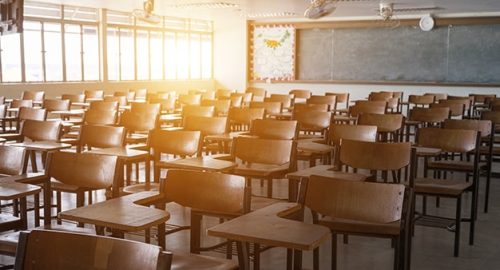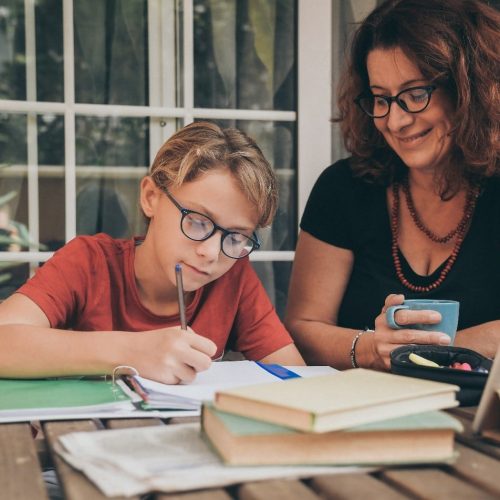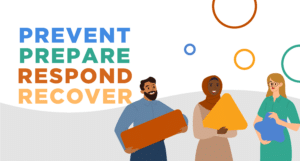In a recent webinar focused on the COVID-19 pandemic, a panel of industry leaders addressed considerations for school safety amongst school closures, as well as preparation for back to school. The four industry leaders include:
- Dr. Stephen Sroka, President of Health Education Consultants and Adjunct Assistant Professor at the School of Medicine, Case Western Reserve University
- William Stencil, Psychologist and Executive Director of Humanware, Cleveland Metropolitan School District
- Mo Canady, Executive Director, National Association of School Resource Officers (NASRO)
- Pat Hamilton, Chief Operating Officer, Adams 12 Five Star Schools
Below are highlights of the panel discussion. You can listen to the full conversation here.
Lessons from past outbreaks that we can draw from today
Dr. Sroka: I have been doing this for decades. I have learned a lot of lessons. Every time we have one of these pandemics, we get hit with so much information. The message I hope we can bring to everyone today is a message I call The Three Agents.The first agent is hope; hope that we are going to make it through this, we are going to do well with this, and it is going to work out. The second agent is honesty and the third agent is to hunker down. We can make a difference with hope, honesty, and hunkering down. I hope today we can provide a calm voice of conscious reasoning and optimism to be prepared not scared. We must work with facts and not fears, with reliable sources like the CDC and your local health department and state department. There are no easy answers. There are only intelligent alternatives.
Mr. Hamilton: At Adams 12, we created a pandemic flu plan shortly after the H1N1 crisis, and I would say that some of that plan applied; however, I do not think any of us ever thought we would see something like COVID-19 in our lifetime. One part of our plan was distance learning. That technology was not nearly as prevalent as it is in our society now. Back then, the concept of one-to-one computing for students was almost unheard of. Our plan talked about social distancing, but we were still not fully ready for it when it came time to implement it. Another key takeaway is just how important it is to maintain our partnerships with our public health agencies and local public health departments. We are fortunate that we have two public health agencies that serve in our district based on the multiple counties that we serve, and those partnerships have been strong since H1N1. They have been a great partner throughout this process thus far and continue to be a partner as we talk about what school will look like when we get a chance to return.
Strategies for maintaining positive relationships with students and the community
Mr. Stencil: We need to keep in mind developmental levels of the youngsters we are working with. Age-appropriate facts and age-appropriate approaches are important here. An honest approach is the best policy no matter how young our kids are. We have to model and share the ideas of being flexible and letting our young people know that there are those working to really minimize the difficulties of this situation. While you are talking with your young people, control your own anxiety. Take care of yourself. Self-care is really important. Ask things like: What have you heard? What are your questions? What are your concerns? All ages need playtime, downtime, and physical activities. Make sure you are ready to support students with academic, social, and emotional learning and create space that is emotionally safe and supportive.
Mr. Canady: We are hearing a lot of incredible stories from NASRO members and what they are doing to help during school closures. Many school resource officers (SROs) are delivering lunches to students, which accomplishes two goals. One is, of course, that it gets meals to students, but it also helps the SRO stay connected in their relationships with the students. The relationships they have built are a fantastic way to stay involved. Some SROs are teaching students through online learning. In some instances, teachers have invited a SRO to join a portion of the online classroom to read a book or share a lesson on law-related education. One of our members created a video for elementary students to help them with physical fitness activities while they are home. Others have helped the Patrol Division watch the school grounds. If you go to the NASRO Facebook page, there are many stories.
Dr. Sroka: I think the biggest concern for those working in schools, whether you are the superintendent or a SRO, is when and how do we open? Reliable organizations such as the CDC and local and state health departments will give us guidelines to follow. There are concerns about testing, grading, and scheduling, but I would say the biggest issue that we will have to respond to is mental health. When kids return to school, they will release their pent-up feelings, like stress and anxiety, and schools must be able to respond not only to their students, but to their staff as well. One way to address this issue is to build relationships with the students and staff. We will need more health professionals in schools, including nurses, psychologists, and other trained professionals who understand the importance of relationships.
Practical advice for managing through school closures
Mr. Hamilton: A major activity most schools are doing currently is meal and resource distribution. We follow the I Love U GuysFoundation?Standard Distribution Method™. Since March 17, we have distributed almost 11,000 Chromebook devices and are now distributing 16,000 meals a day three times a week. We learned that you have to stay flexible, so you can scale your operation and shift your model of distribution to meet the needs of your community. For example, some families in our district cannot drive and pick up the resources, so we are distributing their resources via curbside delivery. Things are constantly changing, so it is important to remain flexible and keep in contact with state and local health departments to ensure you are following proper protocols such as wearing masks. You also must walk through all changes with your staff, explaining the situation and giving them the opportunity to voice any concerns.
Learn more about using Raptor Emergency Management to manage and track meal, homework, and resource delivery on this on-demand webinar.
Mr. Stencil: We know it is important to address the needs of our youngsters, but it is also imperative to focus on the well-being of adults, so that they can take care of our youth. Self-care includes eating and sleeping well, staying hydrated, exercising, and following a daily routine. You should set work boundaries, socialize with others, and take time to recognize and reflect on the good things happening around you daily. I also recommend that you manage your thoughts for positive mental health. This means staying in a growth mindset, being open to change, and creating new and different means of completing your work. Most importantly, I recommend that you shut down when you need to; turn off the computer and the news and take a moment to relax.
Whats next?
Mr. Canady: Something that has weighed heavy on my mind is physical safety. Educators, parents, and students are used to being out for summer, but when we return to school, many students will have been isolated at home for five to six months. I talked to school psychologists about this concern, and we agree that we may see an increase in mental health issues as students return to school. Some students are going to be excited. Other students already live in a difficult environment. We all have students who have the best six or seven hours of their day at school, and some students who have their best meals at school. Being in a difficult environment at home24 hours a day for much longer than they are used to is going to add a new level of mental health components and issues. We need to be prepared to respond. While students are at home, SROs are using meal delivery time to check on the well-being of students. There is a lot of interaction that can still take place at a distance. If you see or sense that the child is in a dangerous situation, you can get the right people involved to resolve the situation.
Watch the webinar Addressing Emotional Poverty During COVID-19 What you need to do now to prepare for safer schools here.
Mr. Hamilton: We are assuming that social distancing will remain in place when schools open. California and the CDC have issued ideas about splitting the school day or week to create more distance and so only half of the people are in the classroom at a time. We are talking to our principals to determine how we can incorporate our mobile buildings into a more standard classroom space. Contact tracing will be another key component to our plan, hopefully preventing any type of hotspot from occurring within our schools. We plan to use the Raptor Visitor Management system to track who is in our buildings and we will potentially add sign-in questions for our staff members and/or visitors to answer before getting access. We are also looking into machines and devices that scan body temperature, but again, you can be contagious without having a fever so contact tracing is a critical component.
Prepare for Back-to-School with Raptor Technologies
As a partner to over 32,000 K-12 schools in the U.S., Raptor empowers educators and district leadership to protect their students, staff, and schools through integrated school safety solutions. Our visitor management system also enables you to capture and report on custom COVID-19 screening questions and facilitate contact tracing once confirmed cases have been identified. Learn more on our COVID-19 resource page.






